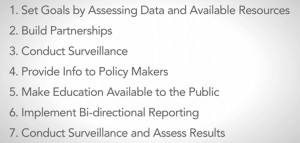Public Health Genomics to Save Lives: Available Tools, Actual Examples, Real Success
Posted on by
Announcing New Tier 1 CDC Public Health Genomics Toolkit and Video Resources
Impact… Scalability… Innovation… Evidence-based interventions… Surveillance and evaluation… Partnerships… Timely information to health care, the public, and decision makers… Commitment… These elements are crucial to any public health accomplishment and are recurring themes in 2 new public health genomics resources.
Nearly 2 million people in the United States are at increased risk for adverse health outcomes due to one of the following conditions Lynch syndrome (LS), hereditary breast/ovarian cancer (HBOC), and familial hypercholesterolemia (FH). Because, at present, these conditions are poorly ascertained by the healthcare system, many individuals and families affected by them are not aware that they are at risk; however, early detection and intervention could significantly reduce morbidity and mortality. Because of their unique ability to partner, facilitate, and provide leadership across the health sector, public health departments have important roles to play in reducing the burden of these conditions.

Public health genomics implementation to save lives – from national vision to state success is a video produced in partnership with Genetic Alliance featuring prominent public health and health care provider, payer, and patient leaders. The web available program provides a scope that moves from the national vision for impact to actual achievement in one specific state example: Michigan. The video includes a primary focus on LS and HBOC and includes specific key steps to be taken, the crucial importance of partners, lessons learned, results, and next steps.
CDC Tier 1 Genomic Applications Toolkit for Public Health Departments
The new CDC Toolkit focuses on specific evidence-based applications to prevent cancer and heart disease for persons at risk from LS, HBOC, and FH and provides key background information, tools and real world examples to help states to develop or build upon existing Tier 1 programs. The Toolkit is designed to include the materials of greatest interest to states but also provides links to much more detailed resources. As an example one of the tools included is another video: Tier I Genomic Applications and Pioneer States which provides useful information for state health department personnel interested in implementing Tier 1 genomic applications. The video features informal interviews by Sharon Terry of Genetic Alliance with state health department pioneers in Connecticut, Oregon, and Michigan.
While the potential of the three applications highlighted in the Toolkit is great there are several other Tier 1 applications which are yet to be fully explored in practice. As the field evolves, the Office of Public Health Genomics will continue to update and expand the Tier 1 applications table and the Toolkit. We are interested in getting input and feedback about these tools and what to include in future editions of the Toolkit.
 Dr. Francis Collins, Director, NIH; Dr. Muin Khoury, Director, Office of Public Health Genomics, CDC; Dr. Robert T. Croyle, Director, Division of Cancer Control and Population Sciences, NIH; Janice Bach; MS, CGC, Michigan Department of Community Health
Dr. Francis Collins, Director, NIH; Dr. Muin Khoury, Director, Office of Public Health Genomics, CDC; Dr. Robert T. Croyle, Director, Division of Cancer Control and Population Sciences, NIH; Janice Bach; MS, CGC, Michigan Department of Community Health


Posted on by



